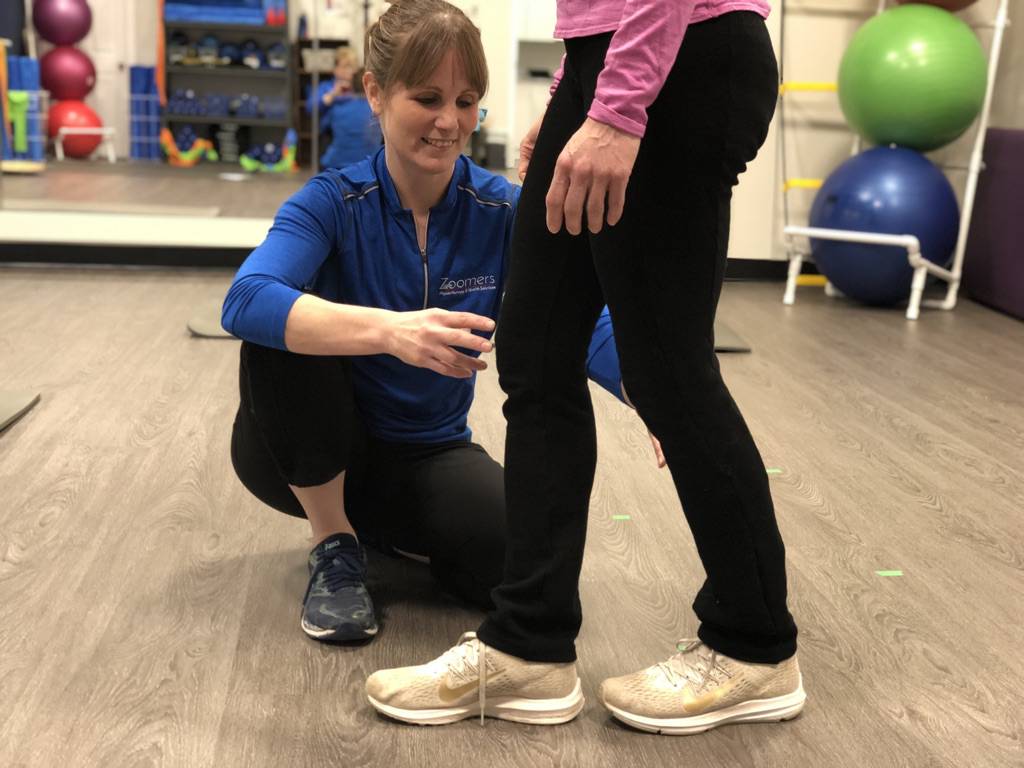Book an assessment with Zoomers now!
Use our online booking tool to find a time that works for you!
Boost your Balance with Active Rehabilitation… Walk Better
Laura Lundquist, PT
In some of my other articles, I discussed ways in which active rehabilitation (such as leg and core strengthening) affects our ability to walk well. Along with strength, balance and agility are also integral to being able to walk well and can be improved with active rehabilitation.
Balance and agility require coordination between your visual, vestibular (inner ear), muscular and proprioceptive (ability of your body to know “where it is”) systems. Active rehabilitation can address these systems and improve your ability to walk well. Here are 2 of my favourite exercises!
Active Rehabilitation Exercise #1: Single Leg Stance
I am often asked why standing on one leg is such a valuable exercise in active rehabilitation. Obvious examples of when we might use this position are activities like putting our shoes on or getting dressed. However, single-leg stance is also present in every step we take when walking; walking is simply a single-leg stance on one leg, followed by a single-leg stance on the other, repeated. Having good stability in the single-leg stance position allows us the ability to change direction, pause or stop suddenly with good control while walking. As a physiotherapist, I will often use this exercise in a client’s active rehabilitation program.
This exercise can be practiced safely at home, making it a great option to incorporate into your own active rehabilitation. Position yourself facing the countertop, shift your weight into one leg, lift the opposite leg and hold this position for as long as you can. Ideally you should be able to hold this position comfortably for 20 seconds. At first you should hold the countertop. As your confidence and ability improve with active rehabilitation, you may be able to hold longer or have your hands hover over the countertop for safety (so you can grab it if you need to). Never let yourself sway out of control. Repeating this 3-5 times on each side daily can substantially improve your balance and agility while walking. No wonder it’s such an important part of an active rehabilitation program!
Active Rehabilitation Exercise #2: Tandem Stance
Although most of us aren’t on balance beams regularly, we do often have to maneuver behind a chair or in a small space; this can require stepping one foot directly in front of the other (as though on a balance beam). This position is difficult to control because the base of support under your body is much smaller than normal.
The tandem stance position involves having one foot in front of the other so that the heel of your front foot touches the toes of your back foot. Ensure you have a countertop in front of you or sturdy chairs on either side that you can grasp for balance as needed (safety is always important to remember when practicing active rehabilitation exercises). Try to hold this position for 15 seconds; never let yourself sway out of control.
If you have any health condition that might make these exercises unsafe or uncomfortable for you, it is best to consult your physiotherapist before engaging in an active rehabilitation program.
I hope you have found this article on the benefits of active rehabilitation with walking to be useful. Remember, walking well requires good patterning, strong muscles and good balance. Our ability to walk well can change over time due to changes in these systems. If you feel your walking has changed, consider booking a physiotherapy assessment with a Zoomers Physiotherapist. We work to help you take back control of this important aspect of your physical health and independence.
Book an assessment with Zoomers
Use our online booking tool to find a time that works for you!


